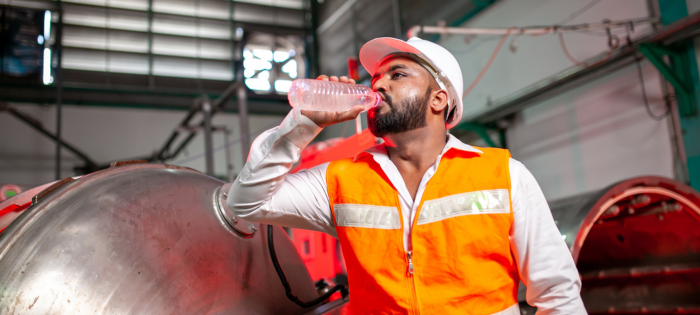
Safety
Comments: No Comments
Safe + Sound Week
According to the Occupational Safety and Health Administration (OSHA), thousands of workers become sick from occupational heat exposure each year—and some of these cases turn fatal. Hazardous heat exposure can occur indoors or outdoors, during any season, and to anyone. This is why it is important that all employers take steps to reduce heat exposure and protect employee health and safety.
Heat-Related Illnesses and Injuries
Exposure to extreme heat (i.e., heat stress) can result in occupational illnesses and injuries, including heat stroke, heat exhaustion, heat cramps, or heat rashes. Heat can also increase the risk of ancillary injuries due to sweaty palms, fogged-up safety glasses, dizziness, and even deterioration of fine motor performance. Burns may also occur from accidental contact with hot surfaces or steam.
Heat stroke is the most serious heat-related disorder and should be considered a medical emergency. It occurs when the body becomes unable to control its own temperature. Workers suffering from heat stroke may experience dizziness or unconsciousness, disorientation, slurred speech, chills, and headache. If you or another employee are suffering from heat stroke, exhaustion, or fainting, alert a supervisor immediately and call 911.
Risk Factors
Workers who are exposed to extreme heat or work in hot environments may be at greater risk of heat stress. This includes both outdoor workers and workers in hot environments (e.g., firefighters, cooks/chefs, bakery workers, farmers, construction workers, miners, boiler room workers, factory workers, and others). Occupational risk factors for heat illness include heavy physical activity, lack of acclimatization, and wearing clothing that holds in body heat. In addition, individuals who may be particularly susceptible to heat-related illness include those who are 65 years of age or older, are overweight, have heart disease or high blood pressure, or take medications that may be affected by extreme heat.
Planning and Prevention
Heat-related illness is often preventable, especially with management commitment to providing the most effective controls. An effective heat-related illness prevention program should be developed and incorporated into every company’s broader safety and health program. Important elements to consider when creating the heat plan include the following:
- Who will provide oversight and heat monitoring throughout the workday as conditions change?
- How will new and/or temporary workers gradually develop heat tolerance (i.e., acclimatization)?
- How will the employer ensure first aid is adequate?
- What is the protocol for summoning medical assistance?
- What engineering controls and administrative work practices will be used to reduce heat stress?
- How will heat stress be measured?
- How will the company respond when the National Weather Service issues a heat advisory or heat warning?
- What training will be provided to workers and supervisors?
Controls
Workplace heat stress can be reduced using several methods. Engineering controls involve changing the design of the workplace in ways that reduce exposure to heat. This might include increasing air velocity; using reflective or heat-absorbing barriers; or reducing steam leaks, wet floors, and humidity. Administrative (workplace) practices involve changes to tasks, schedules, and behaviors to reduce heat stress. These may include:
- Limiting time in the heat and/or increasing recovery time spent in a cool area.
- Increasing the number of workers per task.
- Requiring workers to conduct self-monitoring.
- Creating work groups (i.e., workers, a qualified healthcare provider, and a safety manager) to make decisions on self-monitoring options and standard operating procedures.
- Providing adequate amounts of cool, potable water near the work area and encouraging workers to drink often.
- Using a heat alert program whenever the weather service forecasts a heat wave.
Acclimatization— the process of building heat tolerance—is a particularly important control. 50% to 70% of outdoor fatalities occur in the first few days of working in warm or hot environments because the body needs to build a tolerance to the heat gradually over time. Employers should ensure that new workers, temporary workers, and workers who have been on vacation are acclimatized before they work in a hot environment by gradually increasing workers’ time in hot conditions over 7 to 14 days.
Finally, employers should provide training to workers so they understand what heat stress is, how it affects their health and safety, and how it can be prevented. Training should include:
- Signs and symptoms of heat-related illnesses and administration of first aid.
- Causes of heat-related illnesses and steps to reduce the risk.
- Proper care and use of heat-protective clothing and equipment and the added heat load caused by exertion, clothing, and personal protective equipment.
- Effects of other factors (drugs, alcohol, obesity, etc.) on tolerance to occupational heat stress.
- Acclimatization process.
- Reporting symptoms or signs of heat-related illness.
- Procedures for responding to symptoms of possible heat-related illness and for contacting emergency medical services.
Personal Accountability
To avoid becoming a victim of heat stress of any type, wear light-colored, breathable clothing, such as cotton. Gradually build up to more strenuous work. Schedule more breaks on days with extreme heat and humidity. Drink water! Lots of water! Avoid soda, energy drinks, alcohol, or any other drinks that have high amounts of caffeine and sugar in them. And ALWAYS monitor yourself and others who are at risk for heat stress in hot and /or humid conditions.
More resources:
